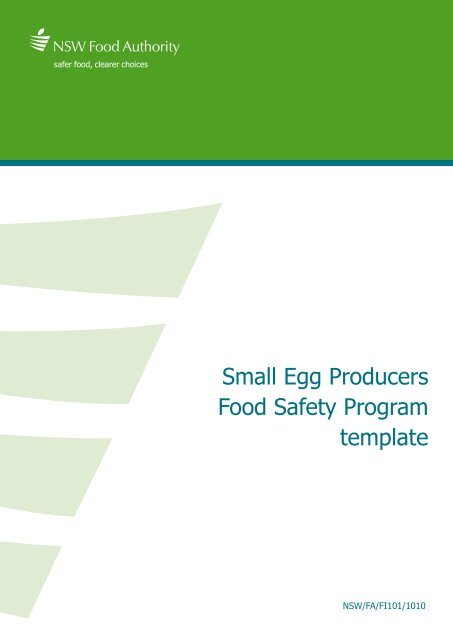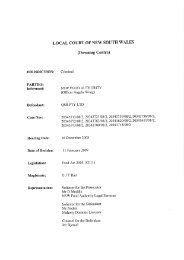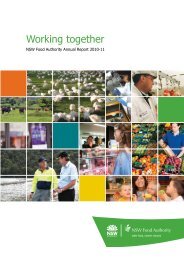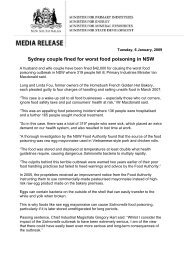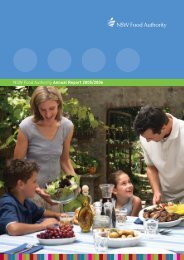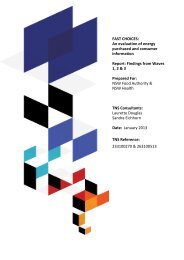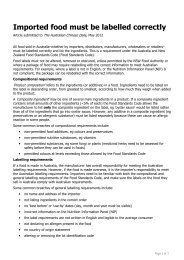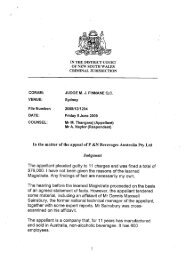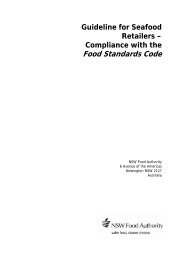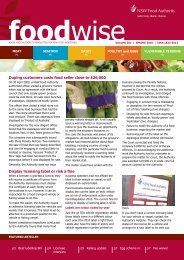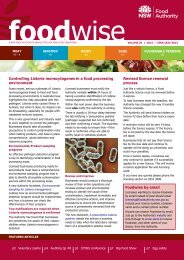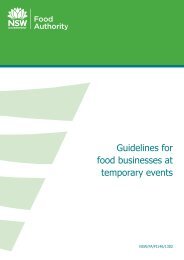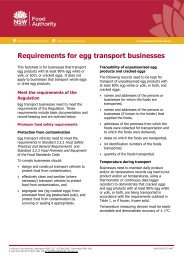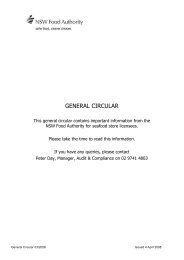Small Egg Producers Food Safety Program Template NSW/FA/FI101
Small Egg Producers Food Safety Program Template NSW/FA/FI101
Small Egg Producers Food Safety Program Template NSW/FA/FI101
You also want an ePaper? Increase the reach of your titles
YUMPU automatically turns print PDFs into web optimized ePapers that Google loves.
<strong>Small</strong> <strong>Egg</strong> <strong>Producers</strong><strong>Food</strong> <strong>Safety</strong> <strong>Program</strong>template<strong>NSW</strong>/<strong>FA</strong>/<strong>FI101</strong>/1010
ContentsIntroduction………………………………………………………………………………………3About the <strong>NSW</strong> <strong>Food</strong> Authority………………………………………………………………………3What is a food safety program?........................................................................3About this document…………………………………………………………………………………….3How do I use this document?...........................................................................3Management responsibility…………………………………………………………………..4<strong>Food</strong> safety commitment………………………………………………………………………………4Scope ………………………………………………………………………………………………………..4<strong>Egg</strong> production activities……………………………………………………………………..4Collection……………………………………………………………………………………………………4Grading………………………………………………………………………………………………………4(a) Crack detection………………………………………………………………………….4(b) Dry cleaning dirty eggs……………………………………………………………….4Storage………………………………………………………………………………………………………5Transport……………………………………………………………………………………………………5Annual review……………………………………………………………………………………………..5Inputs……………………………………………………………………………………………..5Water………………………………………………………………………………………………………..5Stock food………………………………………………………………………………………………….5Pesticides and veterinary medicines………………………………………………………………5Packaging materials and oil………………………………………………………………………….5Waste disposal………………………………………………………………………………….6Birds………………………………………………………………………………………………………….6Manure………………………………………………………………………………………………………6<strong>Egg</strong>s………………………………………………………………………………………………………….6Health and hygiene requirements…………………………………………………………6Skills and knowledge………………………………………………………………………… 6Design, construction and maintenance of premises, equipment and transportationvehicles……………………………………………………………………………………………7Premises, equipment and transport vehicles…………………………………………………..7Cleaning and sanitation………………………………………………………………………………..7(a) Laying environment……………………………………………………………………7(b) Grading room…………………………………………………………………………….7(c) Cleaning chemicals……………………………………………………………………. 7Pest control…………………………………………………………………………………………………7(a) Laying environment……………………………………………………………………7(b) Grading room…………………………………………………………………………….7Bird health………………………………………………………………………………………..7<strong>Small</strong> <strong>Egg</strong> <strong>Producers</strong> <strong>Food</strong> <strong>Safety</strong> <strong>Program</strong> template Page 1 of 11
Traceability……………………………………………………………………………………….8Form 1: Monthly FSP Monitoring Checklist……………………………………………..9Form 2: Veterinary Medicine Record……………………………………………………..10Form 3: Annual Review………………………………………………………………………11<strong>Small</strong> <strong>Egg</strong> <strong>Producers</strong> <strong>Food</strong> <strong>Safety</strong> <strong>Program</strong> template Page 2 of 11
IntroductionAbout the <strong>NSW</strong> <strong>Food</strong> AuthorityThe <strong>NSW</strong> <strong>Food</strong> Authority (the Authority) is a state government agency established in April2004. The Authority was formed by merging Safe<strong>Food</strong> <strong>NSW</strong> with the food regulatory activitiesof <strong>NSW</strong> Health.The Authority is responsible for food safety in <strong>NSW</strong> from primary production to point-of-saleas well as other requirements of the <strong>Food</strong> Act 2003, <strong>Food</strong> Regulation 2010 and the <strong>Food</strong>Standards Code.The <strong>Egg</strong> <strong>Food</strong> <strong>Safety</strong> Scheme (Part 10 of <strong>Food</strong> Regulation 2010) requires certain eggbusinesses to be licensed with the Authority and develop and implement a food safetyprogram that complies with Standard 3.2.1 – <strong>Food</strong> <strong>Safety</strong> <strong>Program</strong>s of the <strong>Food</strong> StandardsCode. This Standard is available at www.foodstandards.gov.auWhat is a food safety program?A food safety program (FSP) is a written document that shows a business has examined theirfood production activities and identified all potential food safety hazards. An FSP outlines howthese hazards are controlled, corrective action if they are not controlled, regular review of theprogram, and appropriate records to be kept.About this documentThis is an official document published by the Authority to assist egg producers comply withtheir legal requirement to develop and implement an FSP. It also aims to reduce the time andresources needed by a business to comply with the Regulation.This document has been specifically developed for small egg producers that primarily selltheir eggs at farm gate or farmers markets. It includes typical production operationsundertaken by these businesses. It also includes additional food safety procedures that mustbe followed to ensure that eggs are safe (eg personal hygiene, structural requirements,cleaning, pest control).How do I use this document?This document needs to include all the production operations and food safety proceduresundertaken by a business. It also needs to reflect how these operations and procedures areundertaken. Therefore, this document may need to be customised.For example, businesses that do not use pesticides or oil eggs after grading will need toremove these procedures from their FSP, or businesses that sell cracked eggs as stock food,instead of disposing of them, will need to change their crack detection procedure accordingly.Alternatively, businesses that wet wash eggs, collect pulp or sell cracked eggs will need toinclude these operations in their FSP. The Authority has developed information sheets thatoutline the minimum requirements for these operations. These information sheets areavailable atwww.foodauthority.nsw.gov.au/industry/industry%2Dsector%2Drequirements/eggs/However, if businesses undertake all the production operations and food safety proceduresincluded in this document they may adopt it in full.<strong>Small</strong> <strong>Egg</strong> <strong>Producers</strong> <strong>Food</strong> <strong>Safety</strong> <strong>Program</strong> template Page 3 of 11
Management responsibility<strong>Food</strong> safety commitment____________________________________is committed to maintaining this food safetyprogram so that:• the eggs produced and sold are safe and suitable for human consumption, and• the business complies with the requirements of <strong>Food</strong> Act 2003 and <strong>Food</strong> Regulation 2010.ScopeThis food safety program covers the collection, grading (including crack detection and drycleaning dirty eggs), storage and transport of eggs sold for human consumption.<strong>Egg</strong> production operationsCollectionPotential food safety riskCollection equipment, laying environment or leakers contaminate eggs with Salmonella.How to control this riskCollection trays that are visibly dirty, damp or contain egg liquid are cleaned or discarded.Laying environment is kept clean and in good repair.Leakers are removed, and disposed of, frequently enough from the laying environment tominimise any build-up of egg product and shell.GradingPotential food safety riskVisual and hairline cracks, and dirt (ie visible faeces, soil or other matter) contaminate eggswith Salmonella.How to control this risk(a) Crack detectionAll eggs are examined by an acceptable method eg candling for visual and hairline cracksbefore they are sold.Cracked eggs are not sold for human consumption. They are segregated and disposed ofhygienically away from clean intact eggs.(b) Dry cleaning dirty eggsHow to control this riskDirty eggs are not sold for human consumption. Only eggs that are visibly dirty are cleaned.Dirty eggs are dry cleaned so that visible faeces, soil or other matter is removed from theshell.Dirty eggs are cleaned with a dry cloth that is changed when visibly dirty. Dirty cloths arecleaned and sanitised after use.<strong>Egg</strong>s with visible faeces, soil or other matter that cannot be removed by dry cleaning aresegregated and disposed of hygienically away from clean intact eggs.<strong>Small</strong> <strong>Egg</strong> <strong>Producers</strong> <strong>Food</strong> <strong>Safety</strong> <strong>Program</strong> template Page 4 of 11
StoragePotential food safety risk<strong>Egg</strong>s contaminated with Salmonella during storage.How to control this riskStorage facilities are kept clean and in good repair.TransportPotential food safety risk<strong>Egg</strong>s are contaminated or damaged during transport.How to control this riskTransport vehicles kept clean and in good repair. <strong>Egg</strong>s are adequately packed andtransported to prevent damage during transportation.Annual reviewTo ensure operational compliance with procedures as well as assessing the accuracy andeffectiveness of this food safety program, a review by the producer will be conductedannually as a minimum.Records of the annual review including any corrective actions taken for issues identified arerecorded on Form 3: Annual Review.InputsWaterThe birds primary drinking water is supplied from a clean, good quality (eg no mould oralgae) source.Drinkers are regularly cleaned and at a height that prevents fouling by birds.Stock foodStockfeed is stored to prevent contamination from pests, vermin and other foreign materials.Records are maintained for each stockfeed delivery, including the name and address of thesupplier from whom feed is purchased, and the date and batch details of stock fooddeliveries. The supplier’s invoice will be maintained for this record.Feeders are regularly cleaned.Pesticides and veterinary medicinesAll pesticides and veterinary medicines are registered for use with the Australian Pesticidesand Veterinary Medicines Authority. This register is available at www.apvma.gov.au. Theyused and stored according to the manufacturer’s instructions.Packaging materials and oilPackaging materials and oil used in the oiling of eggs are suitable for contact with food. Thesupplier will provide this information.<strong>Small</strong> <strong>Egg</strong> <strong>Producers</strong> <strong>Food</strong> <strong>Safety</strong> <strong>Program</strong> template Page 5 of 11
Waste disposalBirdsDead birds are promptly removed from the laying environment and disposed of in adesignated facility on a daily basis.ManureManure is removed often enough to minimise cross contamination between egg, bird andmanure.<strong>Egg</strong>sLeakers are not sold for human consumption. They are discarded hygienically and away fromclean intact eggs.Health and hygiene requirements<strong>Egg</strong> handlers and visitors follow the hygiene checklist below to make sure their personalhealth and hygiene practices do not contaminate eggs.Hygiene checklist for egg handlers and visitorsRisk Procedure Corrective actionContamination of eggsExample – egg handlers withunclean hands, clothing oruncovered woundsBody and outer clothing ofpersonnel handling eggs isclean at start of operationseach day<strong>Egg</strong> handlers are free fromknown infectious diseases<strong>Egg</strong> handlers cover openwounds with a secure andwaterproof bandage<strong>Egg</strong> handlers wash handswhenever it is likely thattheir hands couldcontaminate eggs (ie afterhandling sick birds; afterremoving dead birds fromlaying environment; aftervisiting the toilet; after mealbreaks)Wash hands thoroughly withsoap and sanitiser (or usegloves); change into cleanouter clothingDo not engage in handlingeggsSecurely apply waterproofbandagesDiscard contaminated eggs;wash hands thoroughly withsoap and sanitiser (or usegloves); retrain staffhandling eggsSkills and knowledge<strong>Egg</strong> handlers have appropriate skills and knowledge of safe food handling and food hygieneto enable them to perform their job safely and competently.<strong>Egg</strong> handlers are made aware of their responsibilities according to this FSP.<strong>Small</strong> <strong>Egg</strong> <strong>Producers</strong> <strong>Food</strong> <strong>Safety</strong> <strong>Program</strong> template Page 6 of 11
Design, construction and maintenance of premises, equipment andtransportation vehiclesPremises, equipment and transport vehiclesThe premises, equipment and transport vehicles are designed and constructed to:• minimise the risk of eggs being contaminated,• allow for the premises, equipment and transport vehicles to be effectively cleaned, and• minimise the harbourage of pests.The premises, equipment and transport vehicles are maintained in good working order.Monthly inspections to identify construction and maintenance issues relating to the premisesand equipment are recorded on Form 1: Monthly FSP Monitoring Checklist.Cleaning and sanitation(a) Laying environmentEquipment that comes into contact with eggs is cleaned often enough to ensure it is freefrom heavy soiling.(b) Grading roomFittings, fixtures and equipment in the grading room are cleaned and sanitised (egg contactsurfaces only) whenever it is necessary to prevent eggs from being contaminated.All egg contact surfaces are cleaned and sanitised between use.(c) Cleaning chemicalsChemicals used to clean equipment that come into contact with eggs are suitable for contactwith food. The supplier will provide this information.Chemicals are labelled, stored and handled to prevent contamination, and used in accordancewith the manufacturer’s instructions.Pest control(a) Laying environmentThe laying environment, including feed and water storage facilities, is constructed andmaintained to minimise the entry of pests and the congregation of wild birds.(b) Grading roomDoors will be kept closed as much as possible to minimise the entry of flies.The grading room is kept in good repair to minimise the entry or harbourage of pests.The area outside the grading room is kept clean and tidy to minimise the harbourage ofpests. This includes mowing or reducing excess grass or weeds, removal of rubbish or unusedequipment.Pest control chemicals used in the grading room are safe for use in a food premises. Thesupplier will provide this information.Any records of pest control undertaken are kept.Bird healthSick birds will be promptly removed from the laying environment and treated or culled.<strong>Small</strong> <strong>Egg</strong> <strong>Producers</strong> <strong>Food</strong> <strong>Safety</strong> <strong>Program</strong> template Page 7 of 11
Form 2: Veterinary Medicine Record is maintained to show observance with the correctwithholding periods when veterinary medicines are administered to birds including the datetreated, drug used, animal treated (e.g. shed number), and observance with the withholdingperiod.Traceability<strong>Egg</strong> cartons for retail sale are labelled to comply with Part 1.2 Labelling and otherInformation Requirements of the <strong>Food</strong> Standards Code. This Standard is available atwww.foodstandards.gov.au and includes:• the name of the food,• the business name and address,• lot identification (date marking may be used instead of the lot identification),• nutrient information panel, and• country of origin.<strong>Small</strong> <strong>Egg</strong> <strong>Producers</strong> <strong>Food</strong> <strong>Safety</strong> <strong>Program</strong> template Page 8 of 11
Form 1: Monthly FSP Monitoring ChecklistSatisfactory () Unsatisfactory () and complete corrective action columnDate: / Corrective actionLaying environmentPremises (eg sheds/barns) tidy and in good repairEquipment (eg feeders, water storage, cages/nestingboxes, collection equipment, waste containers)routinely cleaned and in good repairStorage of feed prevents entry, harbourage orcontamination from pests and verminPesticides/veterinary medicines used and storedaccording to manufacturer’s instructionsProcedures for dealing with sick/dead birds, manureand leakers followedGrading roomCeilings, floors and walls maintained smooth andimperviousDoors, benches and cupboards free from damageand deteriorationLights coveredEquipment and fittings free from rust, corrosion andpeeling paintHand wash basins are operating and accessible, havewarm water, soap and paper towels availableChemicals, cleaning equipment and packaging storedto prevent cross contaminationPremises construction and stored materials notproviding harbourage or entry of pests/verminExternal doors/openings prevent entry of pests,windows have flyscreens attachedPremises and equipment effectively cleaned andsanitised (where applicable)Procedures for crack detection and dry cleaning dirtyeggs followedProcedures for personal health and hygiene followed<strong>Egg</strong>s correctly labelled for traceability as per FSPCompleted by:Signed:<strong>Small</strong> <strong>Egg</strong> <strong>Producers</strong> <strong>Food</strong> <strong>Safety</strong> <strong>Program</strong> template Page 9 of 11
Form 2: Veterinary medicine recordShedtreatedName of drugusedDate usedWithholdingperiodDate eggssoldSigned by<strong>Small</strong> <strong>Egg</strong> <strong>Producers</strong> <strong>Food</strong> <strong>Safety</strong> <strong>Program</strong> template Page 10 of 11
Form 3: Annual reviewSatisfactory () Unsatisfactory () and complete comments/corrective action columnDate: / Comments/corrective actionFSP on site and availableFSP includes all current production operationsFSP procedures followedRecords completed and maintainedIssues identified on Form 1: Monthly FSPChecklist adequately rectifiedReviewed by:Signed:<strong>Small</strong> <strong>Egg</strong> <strong>Producers</strong> <strong>Food</strong> <strong>Safety</strong> <strong>Program</strong> template Page 11 of 11
<strong>NSW</strong> <strong>Food</strong> Authority6 Avenue of the AmericasNewington <strong>NSW</strong> 2127PO Box 6682 Silverwater <strong>NSW</strong> 1811Phone 1300 552 406Fax 02 9647 0026www.foodauthority.nsw.gov.au


